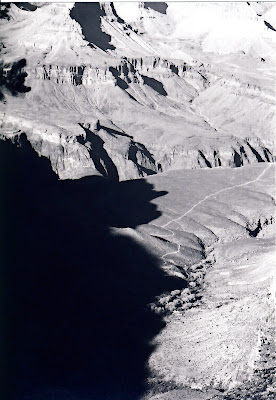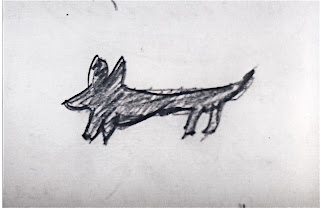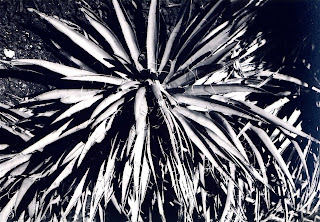
 At the Watchtower
At the Watchtower










 At the Watchtower
At the Watchtower






















Thursday 3 February 2011
Day and night have more ying and yang at the Canyon than they do in Massachusetts.
By day there is not only light but near-biblical Illumination. Bright, unclouded light streams into the apartment, revealing tiny cracks that the dry air pries open in my skin, around my eyes. It pries the Canyon open, too, and fills it with color and form and distance and ravens.
But at night the Canyon becomes a hole—a black hole that wouldn’t even exist without memory’s help. Around 6:30 each evening, after 5 beeps—the alarm setting itself—the last of the shop keepers leaves, and after that there’s no sound but the clock and the wind. Sometimes I play music, but even Bruce-up-loud fills only a corner of the dark black silence. He sounds like a kid whistling to himself on a lonely road.
So this is what electricity is for. I put small lights on in the bedroom and kitchen, marking my trail. The living room is well lit until I go to bed. Bedtime is more sport than activity. It’s like training for an endurance event—long-distance running, maybe—that you approach with fondness, dread, weariness, and a little excitement. You have your rituals, you stretch and prep, and once you get started you hope you’ll find your stride.
I enjoy sitting in bed reading. Books always compete with their surroundings, but in the absence of almost everything they win hands down. Reading at the Canyon is a vivid, holistic experience. I’m drawn wholly into the text. But at the same time I’m not entirely at ease. When I stop reading and look over the top of the spine, I see a double of the bed, the red cloth that hangs behind it to block the window, and a woman in bed reading. It’s the reflection in the studio window, two rooms away on the far side of the apartment, and without my glasses it’s only the suggestion of a reflection.
I’m drawn to it but in a wary way. I wait for it to do something I’m not doing. Or for something to appear that has no match in my room. That I can’t really see it makes this monitoring challenging. It’s pointless, yet irrationally essential.
Reading and looking are preludes to sleep, and sleep is the sport itself. I don’t sleep well here and I don’t know why. After the lights go out I seem to leave the human realm and enter an older, more primitive state. Like an animal whose wellbeing depends on non-stop sensory input, I can’t entirely shut my antennae off. I crave knowledge of what’s going on in the absence of activity and light and company.
There are two sounds: the wind howling—how loud depends on how far I’ve opened the canyon-side window—and the gurgling of the humidifier. The only humidifier on earth that jets out icy-cold steam.
I do sleep. I want to sleep, that’s why I’m in bed. To do so, however, I’ve had to gnaw off the corners of sleeping pills and hope for the best. I fill my mind with imaged static. One night I catalogued my clothes. Another I shopped at Hopi House. The best strategy is talking to the pup, stroking her head as she licks my nose and saying like a mantra, “P knows. P nose. P loves Tenby. P knows.” That often works. I wonder if she feels my touch 3000 miles away, at home.
I wake often, and each time try to claw my way back to my human self so I can retract my antenna. How rested I am in the morning depends on how well I succeed. (Note: I’ve since discovered that sleeplessness is a common response to high altitude. At 7000 ft., the altitude is high and sleep is not forthcoming…)















Click on "The Mary Series" on the lefthand side of my blog to see more images from other locations. One of the mason jar images will be included in the National Park Service Exhibition, "Through Your Eyes," in 2012.